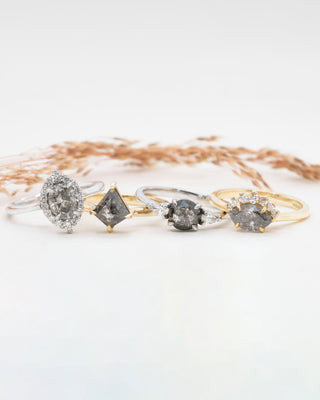Almond Blossoms

Bespoke jewellery stands as a testament to individuality and personal expression, crafting a unique narrative through the artistry of precious metals and gemstones. This specialised approach allows designers to collaborate closely with clients, translating their ideas into wearable art. Jewellery that is created for family holds a profound significance, embodying the bonds and memories that tie generations together.
For our mother and daughter clients, we wanted to create a piece that captured their relationship and a shared love for art. While on a visit to Amsterdam, our clients were inspired by Vincent van Gogh’s ‘Almond blossoms’. This painting, originally created as a celebration the birth of Van Gogh’s nephew, beautifully symbolises close family relationships through intertwining blossom branches and delicate flowers.
In designing the piece for our clients, we aimed to create two separate pendants that could either stand alone or intertwine seamlessly into one. Ensuring a harmonious fit between the pendants was paramount in our design process. Drawing from the intertwining branches of ‘Almond Blossoms’, we envisioned the shape of the pendants, with each branch serving as a guiding motif. Additionally, we incorporated the blossom flowers from the painting into the design, providing an opportunity to integrate diamonds into the design.

Following the initial sketches, we transitioned to creating a 3D model of the pendants using CAD (Computer-Aided Design) technology. CAD allows for a comprehensive rendering of the jewellery piece, enabling adjustments to even the smallest details. Moreover, it offers the flexibility to visualise the pendants in different metals, such as yellow gold or platinum, allowing our clients to see how the final piece could look.


Once the final CAD design was approved by our clients, we proceeded to create a 3D printed cast of the pendants. This tangible prototype allowed our clients to visualise how the pendants will work together, as well as the opportunity to address any design concerns before casting. Our clients also opted to repurpose diamonds from a family ring, infusing their new jewellery with sentimental value.
The casting process uses the 3D printed prototype as a mould for the pendants. This is attached to a wax tree which allows for multiple pieces of jewellery to be cast at the same time. Once the moulds are fitted to the wax tree, they are then placed into casting flasks and filled with plaster and left to set. When the plaster is fully dried, the flasks are then placed into a kiln to melt the wax trees; this then leaves the plaster moulds. While the flasks are in the kiln, metal grains are melted down ready to be added to the moulds. The flasks are then removed from the kiln and the metal is poured in. Once the casts have cooled, they are then cleaned in water to remove any access plaster. The casts then go throw an acid clean to remove any black markings from the kiln process. When this is finished, the pendants can be removed from the tree and polished, ready for the diamonds to be set.
Once the pendants have arrived, we can then send them off, along with our customers ring to have the diamonds set. The flowers on the pendants have been created to fit the different sizes of the diamonds and offers a perfect way to repurpose family jewellery. After the diamonds have been set, we can give the pedants a final polish and check to make sure they are perfect, ready for our clients.


















